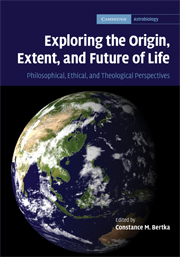 Exploring the Origin, Extent, and Future of Life
Exploring the Origin, Extent, and Future of Life Published online by Cambridge University Press: 29 December 2010
Introduction
In 2003 the American Association for the Advancement of Science, Program of Dialogue on Science, Ethics, and Religion, invited over twenty scholars from diverse fields, scientists active in astrobiology, as well as philosophers, historians, ethicists, and theologians, to explore together the philosophical, ethical, and theological implications of research and discoveries in astrobiology. A major motivation for this effort was the recognition that the very questions that define astrobiology as a discipline – Where do we come from? Are we alone? Where are we going? – are multidisciplinary in nature and have broad appeal to the public-at-large.
It is unavoidable that the science of astrobiology will intersect with, and inevitably challenge, many deeply held beliefs. Exploration possibilities, particularly those that may include the discovery of extraterrestrial life, will continue to challenge us to reconsider our views of nature and our connection to the rest of the universe. Much work has already been done in this area. What is unique about our present circumstance is that past theoretical musings may soon benefit from a renewed urgency that is awakened both by new discoveries and by technological advances. Many of the astrobiologists assembled for this workshop have in common another interest, working proactively to provide more opportunities for non-scientists to both share in the excitement of this field, and to be informed participants in a public dialogue that considers the opportunities and challenges associated with astrobiology in the near future.
To save this book to your Kindle, first ensure [email protected] is added to your Approved Personal Document E-mail List under your Personal Document Settings on the Manage Your Content and Devices page of your Amazon account. Then enter the ‘name’ part of your Kindle email address below. Find out more about saving to your Kindle.
Note you can select to save to either the @free.kindle.com or @kindle.com variations. ‘@free.kindle.com’ emails are free but can only be saved to your device when it is connected to wi-fi. ‘@kindle.com’ emails can be delivered even when you are not connected to wi-fi, but note that service fees apply.
Find out more about the Kindle Personal Document Service.
To save content items to your account, please confirm that you agree to abide by our usage policies. If this is the first time you use this feature, you will be asked to authorise Cambridge Core to connect with your account. Find out more about saving content to Dropbox.
To save content items to your account, please confirm that you agree to abide by our usage policies. If this is the first time you use this feature, you will be asked to authorise Cambridge Core to connect with your account. Find out more about saving content to Google Drive.